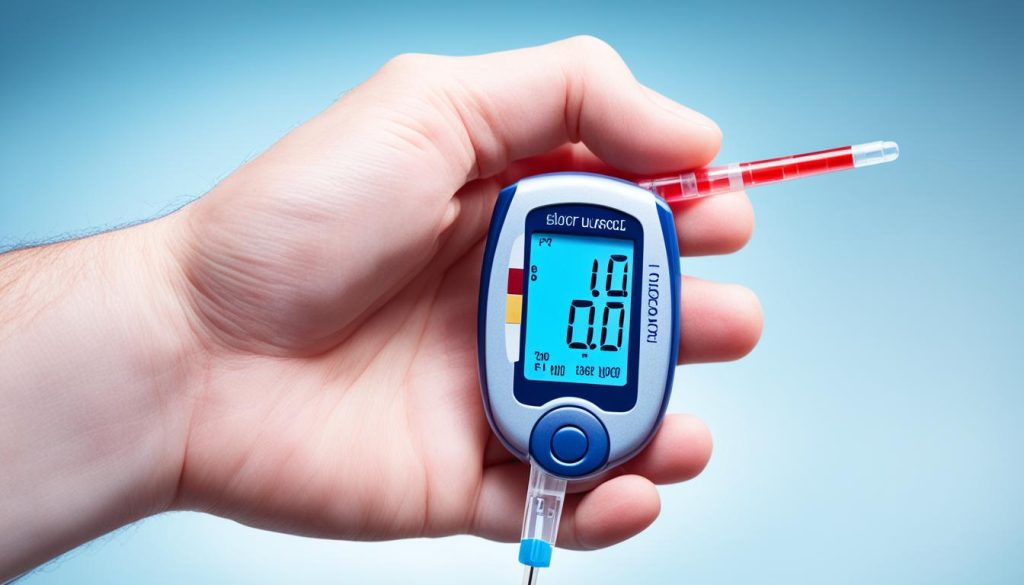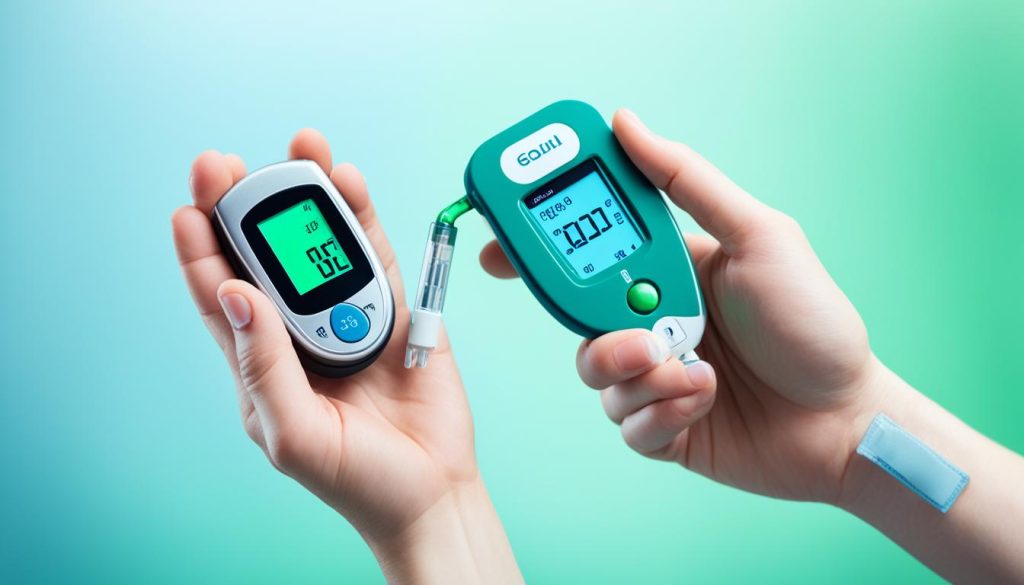Did you know that over 34 million people in the United States have diabetes?
Checking your blood sugar is key to managing diabetes well. It tells you how your body handles your diabetes care plan. This lets you change things if needed for better control.
By checking your sugar levels often, you can avoid problems and stay healthy.
Key Takeaways:
- Regular blood sugar testing is essential for effective diabetes management.
- Testing times may include before meals, after meals, during exercise, and when experiencing symptoms of low blood sugar.
- There are different types of blood sugar testing methods, such as self-monitoring with a blood glucose meter and continuous glucose monitoring.
- Regular blood sugar testing helps track the effectiveness of diabetes medications, adjust insulin doses, and monitor progress towards treatment goals.
- Target blood sugar ranges can vary depending on individual factors, and it’s important to work closely with your healthcare provider to determine the appropriate range for you.
When to Test Your Blood Sugar
Checking your blood sugar levels is key in controlling diabetes. How often you check depends on your diabetes type, treatment, and personal needs.
If you have type 1 diabetes, you might need to check your blood sugar 4 to 10 times a day. Checking often helps you keep track of your levels. This way, you can adjust your diabetes management plan as needed.
People with type 2 diabetes might not need to check as often. Especially if they manage their diabetes with non-insulin medication, diet, and exercise. But, each person’s needs are different.
Key times to check your blood sugar include:
- Before meals and snacks
- After meals
- During exercise
- Before bed
- During sickness or when your daily routine changes
Checking at these times helps you see how your blood sugar changes. It helps you make the right choices for your diabetes care. You can see if your medication works, adjust insulin, and track your treatment goals.
Always talk to your healthcare provider to find out how often you should check. They will help you match your checking routine with your diabetes care plan. This helps you keep your blood sugar under control.
Types of Blood Sugar Testing
There are two main ways to test blood sugar: continuous glucose monitoring (CGM) and using a blood sugar meter. Each method helps manage diabetes effectively.
Continuous Glucose Monitoring (CGM)
A CGM uses a sensor under the skin to track blood sugar day and night. It measures glucose in the interstitial fluid. The data goes to a receiver or an app.
This method gives real-time info. It helps users closely watch their blood sugar levels. They can adjust their diabetes management quickly.
Self-Monitoring Blood Sugar
Self-monitoring blood sugar uses a meter to check glucose with a small blood drop. It gives instant results. People can check their levels anytime they need to.
By checking regularly, they manage their diabetes well. They make better health decisions.
CGM and self-monitoring have their benefits. The right method depends on personal choice and lifestyle. It’s important to talk to a healthcare provider to find what’s best for each person.
Benefits of Blood Sugar Testing
Checking your blood sugar regularly has many benefits for people with diabetes. It helps manage medication, adjust insulin levels, and change lifestyle habits. Here are the main advantages:
- Identifying and Preventing High or Low Blood Sugar Levels: By testing your blood sugar, you can keep an eye on its levels. This helps find and stop too high or too low sugar levels early. It ensures quick action can be taken to avoid further health issues.
- Gaining Insights into the Effects of Diet and Exercise: Regular checks let you see how diet and exercise affect your sugar levels. This way, you learn what foods or activities raise or lower your blood sugar. It helps you make better choices for your health.
- Managing Diabetes Medications: Testing your sugar levels is key to managing your medication. It shows if your medication is working and if you need to adjust it with your doctor’s help. Keeping your sugar at the right level is easier with accurate readings.
- Empowering Self-Care and Active Diabetes Management: When you monitor your sugar at home, you’re in charge of your health. This empowers you to make your own health decisions and talk confidently with your doctor. Knowing your blood sugar helps you make changes for better health.
“Regular blood sugar testing is an essential tool for individuals with diabetes. It helps in identifying and preventing high or low blood sugar levels, tracking the effects of diet and exercise, managing diabetes medications, and empowering individuals to actively participate in their own diabetes management.”
Keeping an eye on your blood sugar is key to handling diabetes well. People with diabetes should check their blood sugar often using reliable methods. By knowing your sugar levels, you can take steps to stay healthy and maintain good sugar control.
| Benefits of Blood Sugar Testing | Key Points |
|---|---|
| Identifying and Preventing High or Low Blood Sugar Levels | Allows prompt treatment and prevention of complications |
| Gaining Insights into the Effects of Diet and Exercise | Helps make informed lifestyle choices |
| Managing Diabetes Medications | Ensures proper medication dosages for optimal glucose control |
| Empowering Self-Care and Active Diabetes Management | Puts individuals in control of their diabetes management |
Using a Blood Glucose Meter
Monitoring blood sugar is key for people with diabetes. A common way to check blood sugar is using a glucose meter. Here’s a guide on using one.
Step 1: Prepare for Testing
Wash your hands well before testing. Clean hands mean accurate test results. Put a test strip into the meter as directed.
Step 2: Obtain a Blood Sample
Prick your fingertip with a lancet. Always use a new lancet. Squeeze out a drop of blood. You can also use other parts of your body, like the forearm. Just follow your meter’s guide for that.
Step 3: Perform the Test
Put the test strip’s edge to the blood drop. The meter will do its job and take in the blood. Wait a bit for the meter to show your blood sugar level.
Step 4: Record and Interpret Results
Keep a log of your blood sugar readings. Note the date and time of each test. Mark down anything that might affect your sugar, like food or exercise. Tracking helps you see patterns in your blood sugar levels.
Talking about your blood sugar levels with your doctor is important. They can help you understand your readings. They also help set goals and adjust your diabetes care plan.
Step 5: Maintenance and Accuracy
Keep your glucose meter clean by following the maker’s care instructions. Check its performance often. Make sure your test strips are not expired.
Regular blood sugar checks give you insights into managing diabetes. This knowledge helps you make smart choices about what you eat, your activities, and your meds. This leads to better blood sugar control and health.
Continuous Glucose Monitoring (CGM)
Continuous glucose monitoring (CGM) is a modern way to check blood sugar levels. It lets people with diabetes see their glucose levels all day and night. This tool has changed how they control their diabetes and make health decisions.
A tiny sensor is put under the skin for CGM, usually on the belly or arm. This sensor checks the sugar in the fluid between cells, which reflects blood sugar levels. It sends the data wirelessly to a device or a smartphone app. Here, users can keep an eye on their blood sugar.
CGMs are great for those with type 1 diabetes who need a lot of insulin. They can also help some people with type 2 diabetes. Especially those using insulin or having trouble controlling their sugar levels.
| Advantages of Continuous Glucose Monitoring (CGM) |
|---|
| Continuous monitoring of blood sugar levels |
| Real-time alerts for high or low blood sugar levels |
| Insights into blood sugar patterns, trends, and fluctuations |
| Ability to track the effects of medication, diet, exercise, and stress on blood sugar levels |
| Improved accuracy in detecting hypoglycemia and hyperglycemia |
CGM offers deep insights into someone’s blood sugar trends. This helps in making quick changes to their diabetes care plan. By tracking glucose nonstop, it’s easier to keep blood sugar stable. This lowers the risk of problems from high or low blood sugar.
Target Blood Sugar Ranges
Managing diabetes means setting goals for blood sugar levels. This helps keep you healthy. The right range depends on your age, how long you’ve had diabetes, your overall health, and your unique needs.
The American Diabetes Association provides guidelines for adults with diabetes. These suggest aim for these blood sugar levels:
A1C levels: Less than 7%
Fasting/preprandial plasma glucose levels: Between 80 and 130 mg/dL
Postprandial plasma glucose levels: Less than 180 mg/dL
These guidelines help manage your blood sugar. Remember, these should be adjusted to fit you. Work with your healthcare team to find the best levels for you.
| Blood Sugar Parameter | Target Range |
|---|---|
| A1C levels | Less than 7% |
| Fasting/preprandial plasma glucose levels | Between 80 and 130 mg/dL |
| Postprandial plasma glucose levels | Less than 180 mg/dL |
Keeping your blood sugar within these targets is key. It leads to better control and less risk of complications. Taking action and working with healthcare experts is important for your health.
Interpreting Blood Sugar Results
Checking your blood sugar is key, but knowing what the numbers mean is even more important. Your blood glucose levels give you insights into how well your diabetes plan is working. It’s crucial to understand how your body reacts to your diet, exercise, medicines, and stress. This understanding guides your diabetes management and helps you make needed changes for better glucose control.
When you look at your blood sugar numbers, pay attention to patterns that show up. You might see high or low levels at certain times of the day. These trends tell you how your body reacts to your care plan. They might show you need to make some changes.
“Understanding your blood sugar results and the patterns they reveal is like solving a puzzle. It allows you to make informed decisions about your diabetes management and take control of your health.” – Dr. Sarah Johnson, Endocrinologist
It’s key to discuss your blood sugar results with your healthcare team or a diabetes educator. They offer insights and help you understand your readings in the bigger picture of your care plan. With their help, you’ll learn how various factors affect your blood sugar. This leads to better decisions about your care.
Think of your blood sugar results as a tool for managing your diabetes. With this info, you can tweak your medicine, your eating and exercise habits, and manage stress. All these help in controlling your glucose better.
Key Takeaways:
- Understanding your blood sugar is vital for seeing if your diabetes plan works.
- Watch for blood sugar trends to find areas you might need to adjust.
- Talk about your results with a healthcare provider for deeper insights.
- Use your blood sugar information to guide the management of your diabetes.

Remember, making sense of your blood sugar is a continuous effort. Keeping track and discussing your levels with your healthcare team supports your aim for the best glucose control and health.
Maintaining a Blood Sugar Log
Keeping a blood sugar log is key for managing diabetes well. You can see how your body reacts to different things by tracking your blood sugar. Make sure to write down when you test, your sugar levels, and anything that might affect your sugar, like meals, exercise, or stress.
A blood sugar log lets you spot patterns in your levels. This helps you adjust your care plan as needed. You might notice changes in your sugar that you and your doctor should look into. Some glucose meters can even save your readings and share them with your phone or computer.
It’s important to share your log with your doctor. They can look at your sugar changes and offer advice tailored to you. Your log is a key part of working together with your doctor. It helps you both make sure you’re managing your diabetes the best you can.
Tips for Accurate Blood Sugar Testing
For effective diabetes care, precise blood glucose testing is key. Following these tips ensures dependable outcomes:
- Wash your hands: Before testing, wash your hands well with soap. This removes substances that could skew your readings.
- Use the appropriate blood sample size: Check your meter’s guide for the right blood amount. Too little or too much affects results.
- Use only test strips made for your specific meter: Meters need certain test strips for accuracy. Use correct strips to keep readings precise.
- Store test strips properly: Store your test strips as the maker advises. Wrong storage harms their function and your results.
- Check expiration dates: Use test strips before they expire. Old strips give wrong readings.
- Clean your meter regularly: A clean meter equals accurate results. Wipe your meter with a soft, dry cloth.
- Perform quality-control checks: Do the quality checks your meter maker suggests. Checking your meter’s accuracy often ensures dependable outcomes.
- Bring your meter to healthcare visits: Show your meter to your doctor to ensure proper use. They can offer help and solve any issues.

By sticking to these tips, you can keep your blood sugar readings accurate. This helps you manage your diabetes better and control glucose efficiently.
Conclusion
Testing your blood sugar often is key to good diabetes care. By doing this, you learn how your body reacts to different things. This includes how it reacts to medicine, diet changes, and other important factors. You can use a blood glucose meter or a continuous monitor to keep track.
It’s crucial to record your blood sugar tests. Then, share these records with your doctor. This helps you and your doctor work together better. You can set goals and adjust your diabetes care as needed. Keeping an eye on your blood sugar lets you manage your diabetes better.
Remember, checking your blood sugar does more than just give you numbers. It helps you learn how your body reacts to many things. This can help you take better care of your diabetes. By keeping track and working with your doctor, you can stay healthy and control your diabetes.




